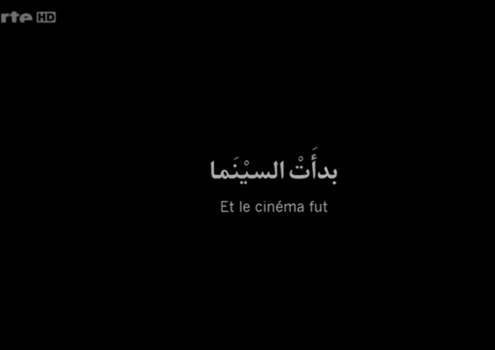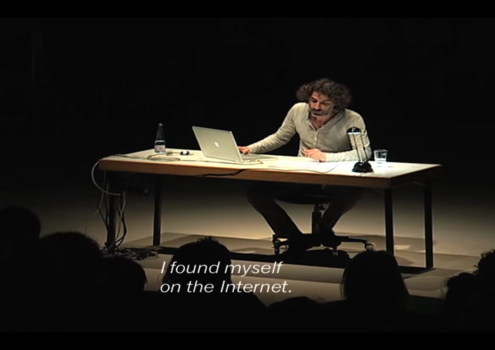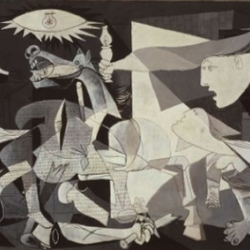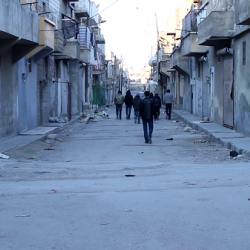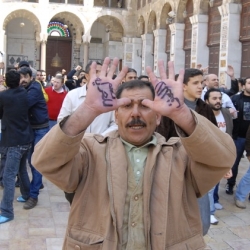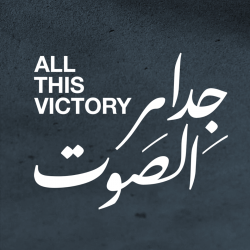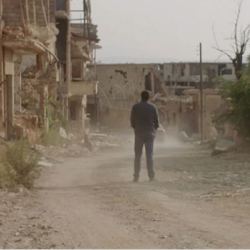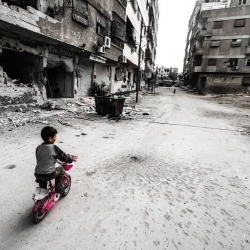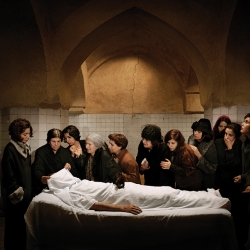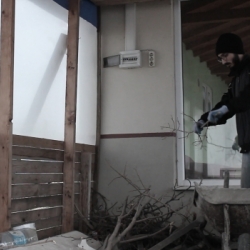What have we been watching? What have we been watching?
05/05/2017
Author: Stefan Tarnowski
The meaning of words no longer had the same relation to things, but was changed by them as they thought fit. Reckless doing was held to be loyal courage; prudent delay was the excuse of a coward; moderation was the disguise of weakness; to know everything was to do nothing.
Thucydides on the corruption of language during the revolution at Corfu in Alasdair MacIntyre, A Short History of Ethics
The question comes to mind more or less every time I click on a clip from Syria. And every time I read an interpretation that tries to fix a single total meaning, another clip would emerge and undermine it. Then when I’d try to begin formulating a theory of videos from Syria, a whole category of clips would elude my analysis. It seems impossible to write a definitive theory of the videos from Syria that emerged with the revolution in 2011.
Debates over the meaning of videos from Syria seem to have died down recently. So now is perhaps a good time to take stock and ask ourselves what we have been watching for the last six years. The point of this exercise is to take some distance from writing about video from Syria that has attempted to categorise clips. Rather, I want to place three frameworks of interpretation side-by-side to probe how each proposes a particular answer to a double-edged question. One edge: what do the images depict – what have we been watching? The other: how should we understand their form – what have we been watching?
Poetic Images from Syria
In a series of slow intertitles the beginning of Silvered Water, Syria Self-Portrait (2014) tells the story of the young boy who grafittied the revolutionary slogan “The people want the fall of the regime” on a wall in his hometown of Deraa. The text tells the founding narrative of the Syrian revolution: the boy’s subsequent arrest and torture, the rapid protestations of his extended family, and the authorities’ nonchalant reply that they should “Forget him. Make more children. And if you can’t manage it, bring us your women and we can help you.” Then, the filmmaker, Ossama Mohammed, makes a provocative claim. There is a fade to black followed by a final intertitle with biblical overtones: “bada’at as-sinama, And there was cinema.” A final fade to black and only then does Mohammed cut to images of the protests in Deraa that are seen as the beginning of the Syrian revolution.
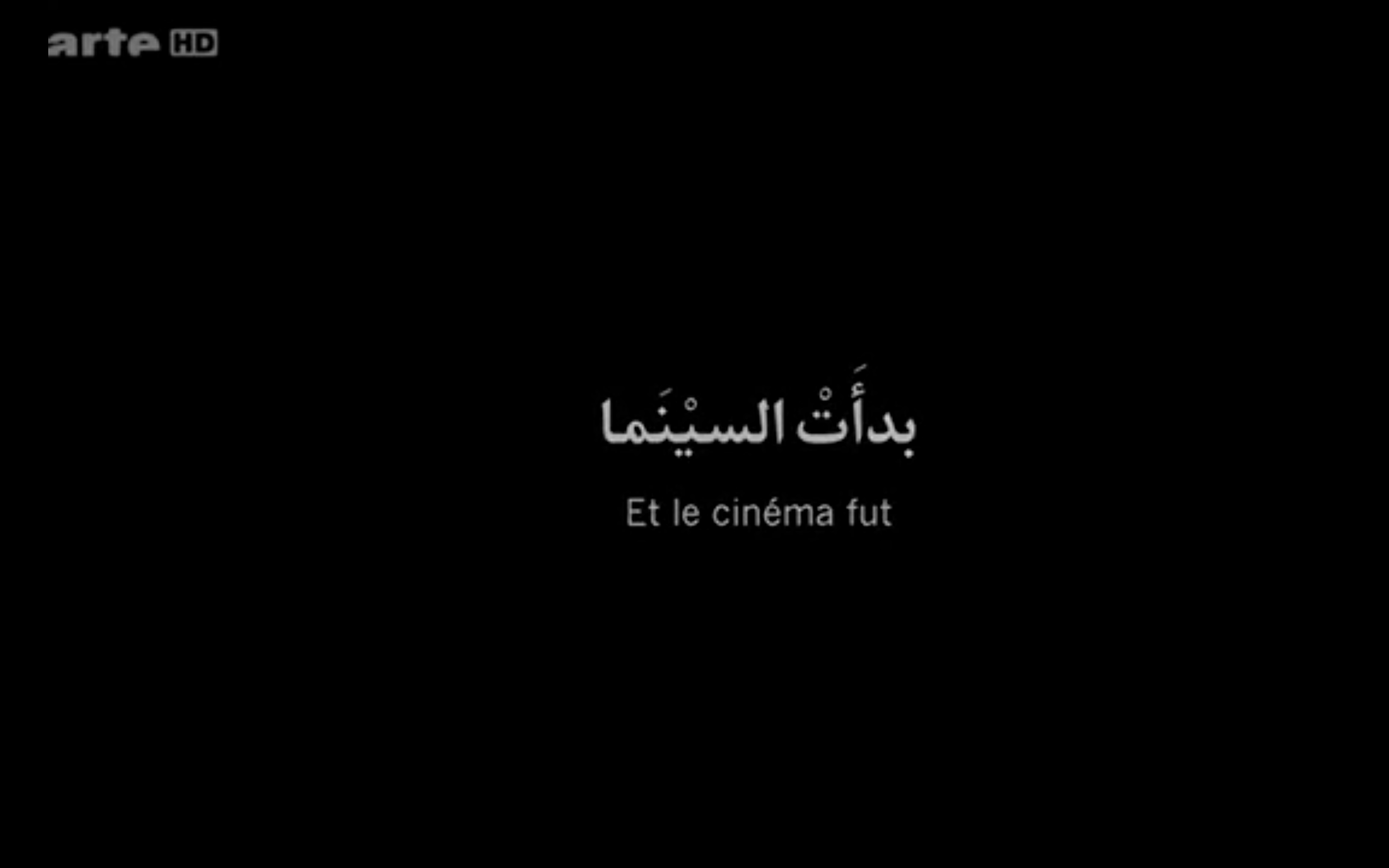
This is the foundational claim of the poetic interpretation of videos from Syria.[1] The videos are cinema and the people who shot them, who Mohammed poetically calls the thousand and one Syrians, are filmmakers. It’s important to stress that revolution and the cinematic image for Ossama Mohammed aren’t coeval: they aren’t born at the same moment. The birth of a certain sort of image heralds the birth of a revolution. And this sort of image is the instrument of revolution. That’s why the intertitle stating “And there was cinema” precedes and brings forth the (images of) protest.
Also in 2014, Zaher Omareen and Chad Elias published an article titled “Syria’s Imperfect Cinema”. Like Ousamma Mohammed, their focus is on the poetic potential of Syrian videos. Mohammed listed the categories of clips as cinematic genres: “Realism, Fantasy”; as well as coining his own genres, “the cinema of the killer, the cinema of the killed”; before finally alighting upon the phrase “Poetic Cinema [sīnamā shā‘iriyya]”. It is as poetic cinema that all the clips can be classified. Zaher Omareen and Chad Elias have different categories but a similar logic. They divide films between “spontaneous and semi-spontaneous videos (amateur filmmakers); semi-professional documentary movies (non-professional filmmakers); and made-for-television and cinema documentary films (professional filmmakers)”.[2] Despite the titles of the categories, the basis for this division is not the modes of production, distribution and circulation, but rather the aesthetic qualities of the images.
Elias and Omareen are particularly interested in the “spontaneous and semi-spontaneous videos” – the clips that Mohammed had termed Poetic Cinema. They propose an interpretation of those images that references Julio Garcia Espinosa’s theory of “Imperfect Cinema”, which argued that technically and artistically masterful cinema is “almost always reactionary cinema”. By eschewing quality and technique Espinosa aimed for a radically democratic cinema that broke the conventions of bourgeois aesthetics. Following this theory, Syria’s imperfect cinema also had radical democratic potential. Harnessing the technological and aesthetic properties of the mobile phone, anyone can become a filmmaker and mobilise the “new audiovisual language”: the shaky, pixelated images; the image and sound unedited; the cameraphone held at arms length.[3]
Other writers such as Peter Snowdon also published variations on this theme. Drawing on Rancière, Snowdon argued that the video footage constituted an attempt at “re-distributing the sensible”. Videos, in other words, were political interventions that created the conditions of possibility for Syrian political aspirations to be made visible to the regime and heard by people around the world.
In his lecture performance and installation The Pixelated Revolution, Rabih Mroué claims that the power of Syrian images is based on their aesthetic properties. And it is this aesthetic quality – the fact that the images are low-res, pixelated, with “low production values” – that imbues the archetypal encounter that Mroué sets up between the protestor shooting with a cameraphone and a soldier shooting with a sniper rifle. “As you may certainly know,” Rabih Mroué informs us from behind a desk, using the mise en scène of an academic lecture to lend authority to his speculations, “the importance of digital images and of their pixelated and low resolution resides in the fact that they originate outside of regulated systems and official institutions.”[4] Although he goes on to give a proviso that authorities, the market and states can appropriate the pixelated image, this is very much a parenthesis. His argument is grounded on a dichotomy between the elusive, revolutionary, low-res image and the commoditised, compromised, high-res image.

Underwriting Mroué’s claims is the celebrated essay “In Defense of the Poor Image” by his sometime collaborator Hito Steyerl. Written two years before the Arab revolutions in 2009, the article became an important basis for much of the celebration of images from Syria and their revolutionary potential. Steyerl argues that there is a hierarchy, a “class society” of images based on sharpness and resolution.[5] On this basis, a seamless analogy could be made: The poor images in Syria rising up to challenge the state controlled media parallel the protestors challenging the regime security forces.
And there was some truth to that. Protestors were using their cameraphones and any other means available to get the word out about what was happening on the ground. It also soon became very clear that the regime was gearing up to use all the force at its disposable to stamp out the protests, and that it was targeting anyone attempting to document them. And with the memories of Aleppo and Hama in the 1970s and ‘80s, Syrians knew the price of silence. There was a genuine struggle for representation. But it was also true that when the Arab revolutions started, Arabic-language satellite TV channels had no qualms about integrating pixelated images seamlessly into their coverage. They were more concerned with providing images than with guaranteeing image quality. In fact, pixelated images gave their coverage an aura of authenticity.
But Rabih Mroué in fact cuts diagonally through this poor vs. state-controlled image and protestor vs. security forces analogy. He argues instead that it is the poor images themselves confronting the regime security forces. It would be excessive to collapse this position into the simplistic technological determinism – the idea of that the Arab uprisings were caused by the mass ownership of smartphones, their technological capabilities and popular mobilisation by social media networks – being debated in the mainstream media. But there are important correspondences between the two positions. The poetic interpretation of images only paid lip service to uncovering how images were made: what were the ever more complex modes of production disguised by the celebrated pixelated aesthetics that allowed clips to be classified simply as ‘user-generated’? And what about the content of the films themselves? Surely there was something amiss to treat a pixelated image of torture, rape, beating, arrest, death at the hands of the regime the same way one would treat a pixelated image of joyful or terrifying protest.
In September 2014, two of my Facebook friends, one in Beirut and the other in Cairo, posted a YouTube clip on Facebook titled Syrian boy plays dead twice to save a little girl from the sniper. Filmed on what seems to be a mobile phone camera, it shows a man escaping from a bombed-out building under sniper fire down a sandy road. A crowd that sounds as if it’s behind the camera shouts encouragement. Panning past a burnt-out car, the camera spots a boy lying in the middle of the road. The cameraman shouts: “He’s moving!” Another man says: “He’s alive, not dead!” The camera captures the boy standing up slowly then running down the road. The sniper fires another shot; a cloud of dust rises next to the boy; the boy stops and falls; the men shout, “God is great!”; one begins to mutter the prayer for the dead as another says, “The boy died.” But the boy gets up again. The crowd cry: “He’s moving!” as the boy grabs a little girl, previously out of frame, sheltering behind the burnt out car. Then under a barrage of sniper fire, he drags her to safety.
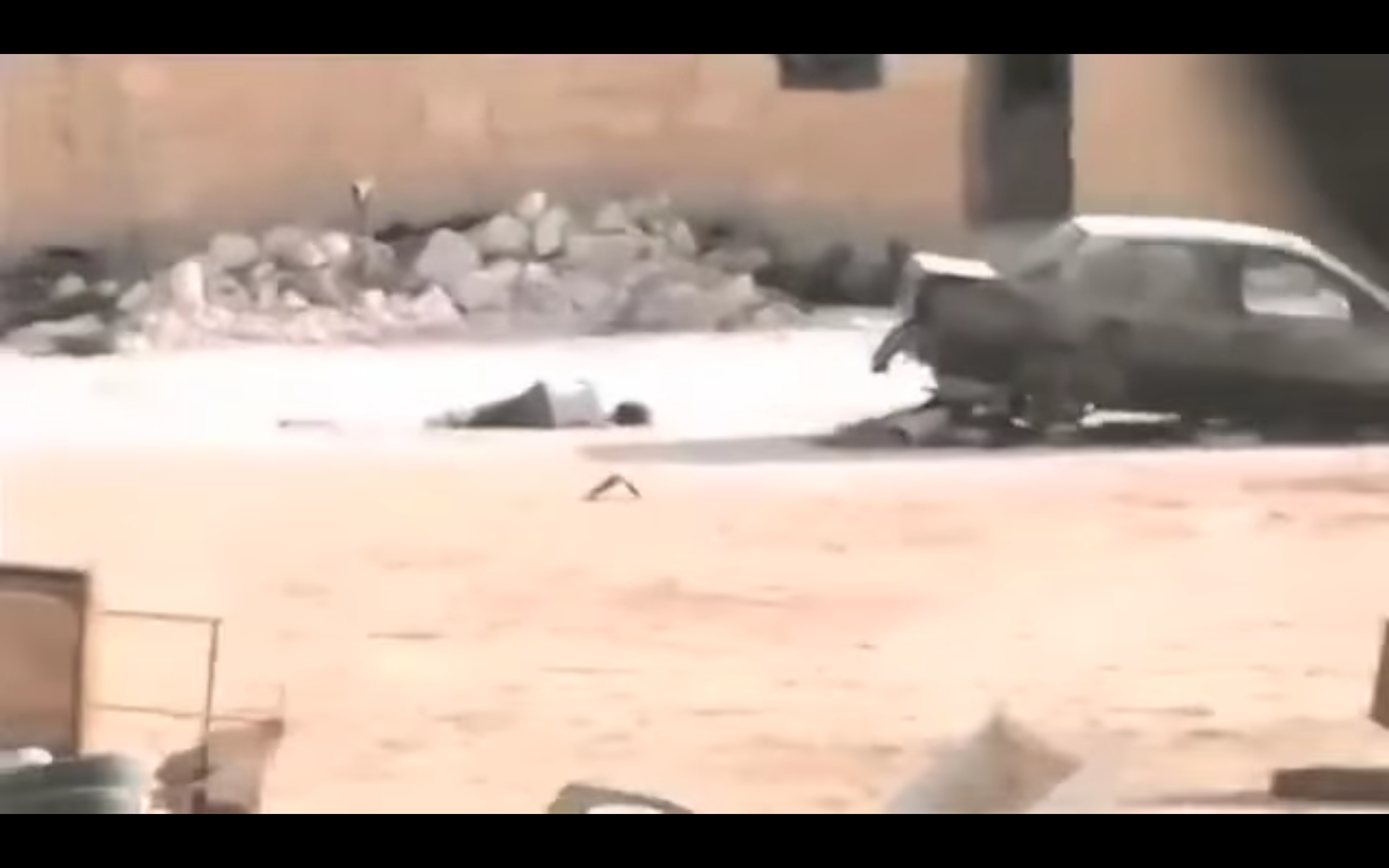
Like the millions who watched the clip, I was deeply moved by it. It seemed to hark back to the heady early days of the revolution, the days of heroic citizen journalists, the days before ISIS, when civilians fearlessly faced down the Assad regime, armed only with their voices, their cameras and the strength of their numbers. The clip went viral, even making the international press, long since a rare feat for good news from Syria.
But it emerged a few weeks later that a certain clip titled Syrian Hero Boy had been faked by a Norwegian director, Lars Klevberg. From ‘behind-the-scenes’ photographs released when the ruse was revealed, the clip appears to have been shot with an expensive SLR. The shaky, hand-held aesthetic of the images was a sort of special effect. The clip, just over a minute long, received £27,000 of funding from the Norwegian Film Institute (NFI). “It was really a low-budget film. People normally apply for more money,” said a commissioner from the NFI.
According to the BBC, the film was posted to the filmmaker’s YouTube account a few weeks earlier. “But the algorithm told us it was not going to trend,” said Klevberg, “so we deleted that and re-posted it.” They added the word ‘hero’ to the title, and posted it on Twitter. Then it was picked up by the Shaam Network, which posted it on YouTube, and it began to attract “international attention.”
The Norwegian filmmaker claimed that he wanted to “spur debate” about events in Syria, especially “innocent children all over the world affected by war”. It was clear that unlike those who had followed events since 2011, Klevberg’s understanding of the footage hadn’t been framed by routine accusations from Syrian state media that YouTube footage is faked, that most of it is staged in a TV studio in Qatar. In fact, the regime has always denounced incriminating opposition footage as staged, and if Klevberg had cared to find this out he might have begun to understand the inappropriateness of his short action film appropriating the popular, pixelated, revolutionary aesthetics to defend the lives of children threatened by war in Syria.
From the regime’s perspective, the clip was read and presented as proof that none of the footage documenting the killing of children was genuine. In an article published on SANA, the Ministry of Information’s online news outlet, also helpfully stated that there are 50 Norwegians currently fighting on the side of ‘terrorist organisations’ – a reference in this case to ISIS – in Syria. The regime obviously saw the value of a burgeoning market for YouTube clips in order to re-affirm its cynical adage: that there was no Syrian revolution, only a media conspiracy, that they are fighting armed terrorist gangs, and that a choice had to be made between Assad and ISIS.
Forensic Images from Syria
The Poetic Interpretation of images cannot account for episodes such as “Syria Hero Boy”. But if the forensic interpretation of images from Syria does anything, it verifies the content of films. It would never have fallen for Klevberg’s spoof.
Eliot Higgins lives in a suburban house in Leicester, a provincial city in the English Midlands. He has never been to Syria, and he doesn’t speak or read Arabic. But he has been hailed as the leading expert on weaponry in Syria and an authority on Syrian video footage. Until the recent launch of Bellingcat, he didn’t have an office, and operated from his front room through a blogspot domain. And yet one journalist described him as having broken more stories in the first three years of his blog than most journalists do in an entire career. He has used footage to prove that despite an arms embargo the US and EU was turning a blind eye to the arming of Syrian rebels with ex-Yugoslav war weapons from Croatia; he has verified countless chemical weapons attacks by the Syrian regime; estimated the probable coordinates for the James Foley execution by ISIS; uncovered and documented the use of cluster bombs by the Syrian regime; and exposed countless lies, deceits and cover-ups by the Russian bombing campaigns of residential areas, schools and hospitals.

Higgins describes himself as someone who is committed to the ethos of open source investigation. In this sense, the fact that he doesn’t speak Arabic or hasn’t been to Syria is of no consequence. Higgins can rely on the online commons, like-minded people to help him decipher and translate, locate and confirm just by sending out a tweet. He is an expert in user generated content, and is happy to share his knowledge on tools and techniques.
For Higgins and the online investigative journalists following in his footsteps a video from Syria can be many things: data to verify or disprove narratives by cross-referencing; evidence of a crime that has been committed; the basis for future justice. In that sense, Higgins has a pragmatic relationship to clips from Syria. They are useful, and this applies equally to footage that is produced by a pro-regime TV station, the Iranian or Russian governments, a drone, an activist, a jihadist militia, a citizen journalist, or simply a satellite. All of it is information, data that can be verified, and then mobilised to attack or defend narratives in order to build up a picture of the truth that can potentially be used in a court of law.
The idea that images contain evidence that can be used as grounds for future justice has come be particularly prominent under the advocacy of Eyal Weizman.[6] Through Forensic Architecture, the research group he directs at Goldsmith’s University, he argues for a new orientation towards images in particular and the material world in general. To hold the state to account by combining the skills of artists, activists, lawyers, journalists and academics is an alluring idea. It is an idea that Weizman argues reflects an underlying shift which his methodology aims to harness:[7]
Within the field of war-crime investigation, a methodological shift has recently led to a certain blurring. The primacy accorded to the witness and to the subjective and linguistic dimension of testimony, trauma, and memory – a primacy that has had such an enormous cultural, aesthetic, and political influence that it has reframed the end of the twentieth century as “the era of the witness” – is gradually being supplemented (not to say bypassed) by an emergent forensic sensibility, an object-oriented juridical culture immersed in matter and materialities, in code and form, and in the presentation of scientific investigations by experts.
Undoubtedly, a primary motivation of Syrian activists has always been an attempt at gathering evidence of abuses at the hands of the regime. The spectre of Hama loomed large from the earliest days of the revolution as the regime fired on unarmed protestors, escalating peaceful protest into armed conflict, releasing jihadis from its jails to form militias and undermine the opposition, filling its formidable network of secret prisons with mass arrests, and then bombing, barrel bombing, and gassing Syrian villages, towns, suburbs, and cities. Foreign journalists have long been rare in Syria and those that remained were closely chaperoned and didn’t manage any noteworthy coverage of the burgeoning revolution. A brief surge in foreign journalists was stamped out by killings and kidnappings. So in the absence of traditional journalists, there were systematic attempts by the emerging LCCs, the Local Coordinating Committees where grassroots democratic politics were taking shape, to distribute cameras and equipment, and to organise workshops to train cameramen how to systematically document regime abuses. This attracted the attention of foreign governments, and there have been reports that the British, Canadians and Dutch provided funding for training and equipment to the LCCs.[8] The figure of the citizen journalist emerged.
But my point is not that there is a category of clips we should understand as ‘forensic’ versus another category we should understand as ‘poetic’. Elliot Higgins or Eyal Weizman don’t necessarily mind who shot the footage or what the intention of the cameraman is – the aim is to “bypass human testimony”.[9] Higgins has said that he’s reluctant to talk to activists on the ground because “I felt it ruined the purity of what I was doing a bit.”[10] It’s in the search for the purity of evidence that regime footage can be as useful as anti-regime footage.
Forensics is a mode of interpreting, analysing, using, exploiting, revealing and constructing truths around images. There is generally a pragmatic aspect to the forensic treatment of material: what does this clip prove? And in the particular use of violent images, there is a sense that the approach can be utilitarian: do the benefits of using a clip outweigh any potential costs or qualms? The utilitarian aspect of the forensic approach is also apparent in the way analysts seems to position themselves outside of the fray, making objective analyses of costs and benefits. Can a particular clip, or a constellation of clips, be marshalled into a particular argument that influences a narrative, proves a point, or elicits an action or a response? The underlying motives are laudable, because ultimately, the forensic investigator asks only whether the image be used to bring about truth and justice.
But let’s return to the initial question: What have we been watching? The forensic interpretation of images never really questions the form of a video. It is satisfied with understanding images as representations of something happening somewhere on the face of the earth, to use Weizmanesque language. Each a crime scene, images are things that leave a mark to be deciphered. In that sense, they are all content, pure data. But while Higgins can, for example, spot all of the militias in possession of a particular weapon system, or track which weapons are being used at any one point in the conflict and thus give an estimate of the conflict’s escalation, the forensic approach never embeds the video in the web of social and technopolitical relations necessary for its production. In recent years in Syria, there is a haste with which the forensic approach is willing to accept received wisdom about the form of images; for example, that footage produced by rebel militias is simply propaganda.[11]
But clips that the forensic interpretation can accept as propaganda might in fact participate more actively in the economy of the war. If only 500 or even just 50 people ever watch one of the countless clips a militia releases firing a specific weapon, say the TOW anti-tank missile, then to what extent can we really call this clip propaganda? The conventional response is that militias release videos of high-tech weaponry to attract recruits. But how likely is that? Are young men in Syria really waiting to see if a specific brigade gets an American anti-tank gun before signing up? There is more at stake, I hope to show, in the form of the image than this interpretation captures.
Commodity Images from Syria
It’s counterintuitive to think of YouTube clips, or social media groups, as commodities. Surely a commodity is something made to be bought and sold? Post-Snowden, the market value of the data we constantly secrete online is widely known. Perhaps because of the frictionless way in which footage is uploaded and accessed, we still largely regard YouTube as the reserve of user-generated material, not material that has resulted from a complex mode of production.
In late 2013, after the failed attempt to convince parliament of the merits of military intervention in the wake of the Assad regime’s chemical weapons attack on a Damascus suburb, the UK government was building ties with the Syrian armed opposition. As documents seen by the Guardian revealed, on 6 November 2014, the British government released three Invitations to Tender (ITTs) to a select group of companies. Marked ‘Commercial – Sensitive’, one of those programmes was titled ‘Strategic Communications and Media Operations Support to the Syrian Moderate Armed Opposition’.
According to the document, the “purpose of the project is to contribute to an effective and credible Syrian MAO [Moderate Armed Opposition] through StratCom [Strategic Communications, in the military jargon of international procurement] and Media Operations capacity building.” The document also implies that the point of the policy – supporting opposition media – is to develop a tactical influence over the Syrian moderate opposition. The document continues: “This should take the form of centrally coordinated support to the RFS [Revolutionary Forces Syria], at the operational and tactical levels, with the capability to expand back into the strategic space as and when the opportunity arises, to help build an effective opposition political-military interface.”
The contract was funded by the UK Conflict Pool. It’s worth understanding what the Conflict Pool is before going into the programme. The Conflict Pool is a fund built up by contributions from four government departments: the Foreign Office, the Ministry of Defence, the Home Office and the Department for International Development (DFID). It works on the idea that conflicts can be prevented or managed through a combination of diplomacy, defence, domestic security and development: the four Ds as they’re known by British civil servants.
Funded by the UK Conflict Pool, the ITT commissioned a company to create a centralised media office for the Free Syrian Army. The UK company that won the bid was Regester Larkin. It was tasked according to the contract with making a change in policy. But YouTube footage and the Free Syrian Army were difficult to centralise. Both were considered useful nonetheless. “Accordingly, a more ‘bottom up’ approach has been pursued,” the document admits. Regester Larkin was willing to continue to pay for clips on behalf of the Conflict Pool.

Operating from their offices near Istanbul Airport, Regester Larkin set up the first of two shell companies staffed by Syrians – the Revolutionary Forces Syria Media Office – to run the Free Syrian Army’s communications. With an upper crust of British staff, only the most senior Syrians working for those companies were aware of Regester Larkin’s deep links with the UK government. Or at least they didn’t ask too many questions since they were being better paid than their colleagues at other media companies.
On their YouTube page, the Revolutionary Forces Syria (RFS) Media Office concerned itself mainly with posting three kinds of clip: documentation of military successes and weaponry at work; meetings between senior officers in the Moderate Armed Opposition (MAO); and clips from TV news featuring senior spokesmen for the MAO. I’m going to focus on the documentation of weaponry at work.
A quick glance at the page demonstrates that the vast majority of this kind of footage depicts a particular weapon at work: the TOW anti-tank missile. TOW is a sophisticated weapon that first appeared on the RFS YouTube page in May 2014. Reports of sightings of the weapon in Syria surfaced in the media about a fortnight earlier – Brown Moses was one of the first blogs to comment on them – and which the Washington Post then revealed were provided as part of the US Train and Equip programme. The first TOW video on the RFS YouTube page has received a mere 450 views until today. Clearly, it was intended for a specialist audience, not the general public.
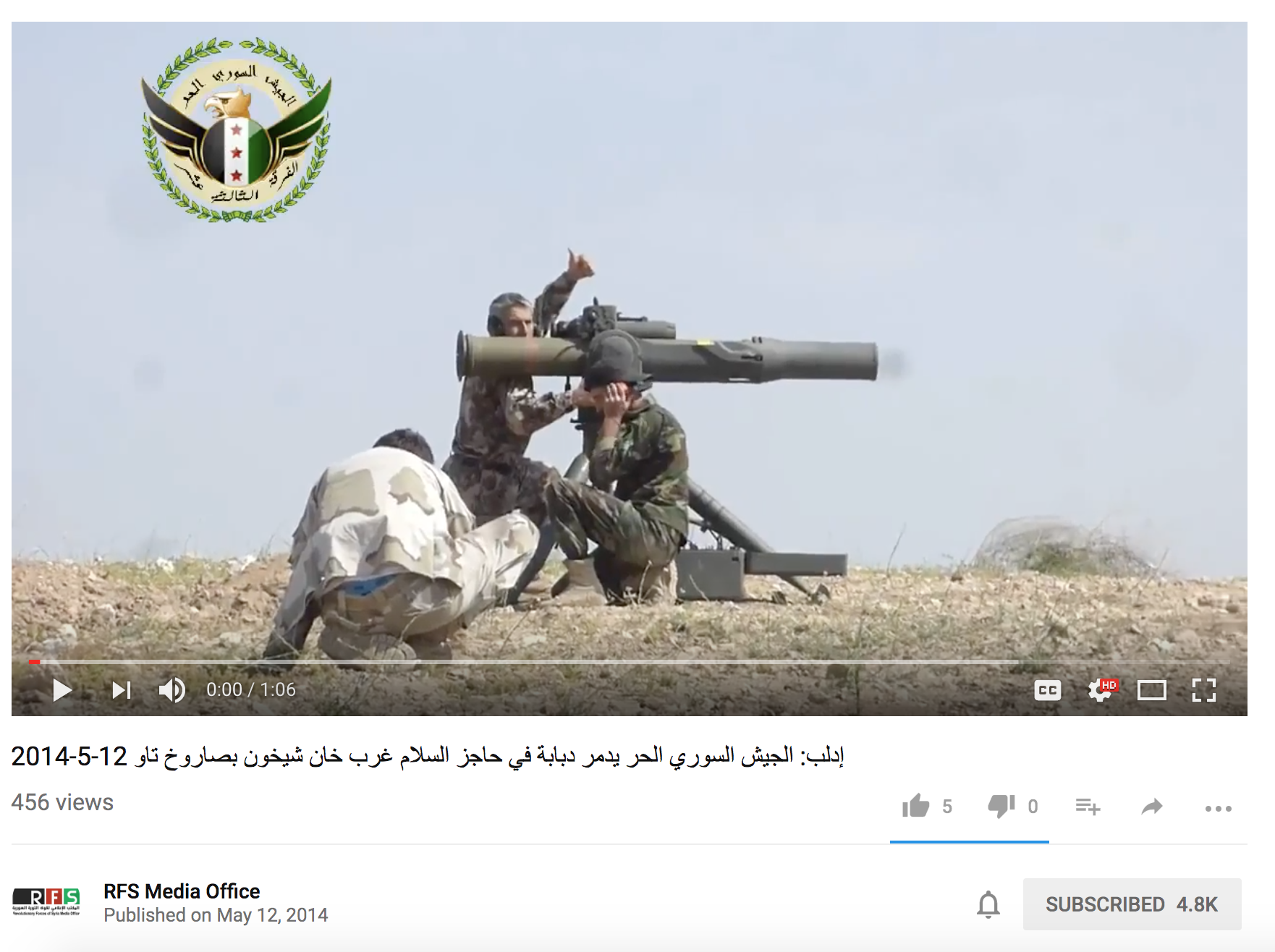
By the summer of 2015, there were over twenty thousand TOW videos sloshing around on YouTube. From interviews, I learnt that the weapon was provided under one condition: that there must be a video documenting every time it is fired, showing the act of firing, the target and whether or not the target was successfully hit, and that video must also be uploaded on YouTube. Only after the video was uploaded would replacement missiles would be provided. Videos uploaded online were exchanged for munitions.
These clips are more than mere representational images, depicting the ‘reality’ of the battlefield. They are commodities, active in the economy of war, and contributing directly to it. Traded for guns, funds and allies, under the direction of Western governments, making a YouTube clip can be an act of war.
There are other routes to discuss the commoditisation of YouTube clips from Syria. Long before videos were exchanged for TOW missiles, newspapers and satellite TV stations were paying for footage, training citizen journalists, and providing equipment. The US government ran a scheme through another subcontracted company to provide satellite Internet towers in response to attempts by the Syrian government to cut off the Internet entirely. So in an infrastructural sense paid for the continued stream of information from Syria’s opposition. I could mention countless other examples I have stumbled across in interviews or read about in articles. In important ways, commoditisation was not a negative. Again, the spectre of Hama, of a massacre shrouded in darkness and conducted in silence, loomed large. The irony is that in its stead, we have a massacre conducted not only in plain sight but also in the knowledge that despite the on going calls for intervention, intervention of a kind is already taking place. But that intervention has been built on social media and smartphone evangelism, and though spectacular, it is ineffective.
What have we been watching?
The three approaches to understanding clips from Syria can be mapped by their answers to the two components of our central question: what do these images depict, and how should we understand their form? According to the poetic reading, the images depict revolution, and their form is revolutionary. For the forensic approach, the reply is that they are images of crime (crime scenes), and images as evidence.
The benefit of understanding YouTube clips as commodities, or at least crypto-commodities,[12] is that it forces us to pay attention to the nexus of material and social relations in which and through which they are produced. It is to understand them as images of congealed and inherently asymmetrical social relations. Images become inextricable from those material and social relations. So one is forced to approach their informational value critically and not take their aesthetic properties at face value.
That is not to say that aesthetics should be dismissed. One of the drawbacks of the forensic interpretation is that it pays little heed to the aesthetic properties of images. The aesthetics of an image are important. They lend an affective force, and they do, as Rancière argues, lead to a ‘distribution of the sensible’ in ways that help make political claims heard. They help to move and mobilise people. But they can also help to discipline populations and restore order.
The poetic interpretation certainly pays attention to aesthetics, but it means therefore that we take ISIS at their word. They use high-res images therefore they are a state. Or we misunderstand regime images of torture. They are pixelated, so we must take at face value the title of the clip when it says it has been leaked out of a regime jail, rather than posted by the regime itself as part of a sophisticated campaign to discipline and terrorise a restive population. This is a central concern regarding Ossama Mohammed’s re-circulation of images of torture and his branding them cinema.
But then, understanding all images from Syria as commodities would have its drawbacks, especially since no system is totalising. How to treat, for example, Abounaddara’s weekly films? They’re certainly of no value to the forensic interpreter: they don’t contain information that can be instrumentalised towards proving or disproving a particular narrative. Their truth is more elusive than that. Nor are they traded as commodities: no one is buying and selling them even if they make their way into the hyper-marketised world of contemporary art. They’re low budget, but they’re shot in high-res. As anonymous clips, their modes of production are obscured so we can only speculate as to their complexity.
Since none of these interpretations is conclusive we are left watching, horrified and captivated by the images from Syria that both uncover and conceal. And we remain aware that what we are analysing is not a totalising system, and therefore that totalising theories will inevitably fall short.
Stefan Tarnowski is a writer, researcher and translator. He is currently a PhD candidate in Columbia University’s Anthropology Department. He previously worked at Beirut Art Center, and was a participant on Ashkal Alwan’s Home Workspace Program. He has also worked as a researcher for a number of artists and filmmakers.
[1] As well as drawing on Mohammed’s categorisation, my use of the term poetic is a rough and ready misuse of Heidegger’s notion of poiesis, bringing forth, discussed in “The Question Concerning Technology”. Poiesis is a sort of unalienated use of technology, the highest form of techne, that he contrasts with ‘enframing’, by which technology is employed for the ‘ordering’ of nature or to extract resources. It’s this unalienated sense that I want to stress in my misuse of Heidegger. For Heidegger, the use of technology always implies great danger, a bit like opening Pandora’s Box, even when it is being used in its fullest or highest sense as poiesis. All of this is implied by my use of ‘Poetic” here.
[2] Chad Elias & Zaher Omareen, “Syria’s Imperfect Cinema”, in Syria Speaks, p. 258
[3] Ibid., p. 262.
[4] Rabih Mroué, “The Pixelated Revolution”, TDR: The Drama Review, Volume 56, Number 3, Fall 2012 (T215), MIT Press, p. 26
[5] Hito Steyerl, “In Defense of the Poor Image”, e-flux, Journal #10, November 2009, http://www.e-flux.com/journal/10/61362/in-defense-of-the-poor-image/, accessed 20 February 2017.
[6] Weizman uses the etymology of Forensic to explain his method: stemming from forensis meaning “pertaining to the forum”. Although we associate forensics mainly with the court of law, the Roman forum was originally a “multidimensional space of politics, law and economy”. Weizman has often used the court of law in his research projects when collaborating with NGOs in his investigations, but he is equally concerned with the multidimensional aspects of the method. He also constructs – the metaphor linking the forensic method to his training as an architect – new forums (fora?) in pursuit of truth and justice that are not necessarily linked to the court of law, including collaborating with artists.
Eyal Weizman, “Introduction: Forensis” in Forensis: The Architecture of Public Truth, ed. E Weizman, Sternberg Press (Berlin: 2014), 9.
[7] Eyal Weizman, Notes from Fields and Forums, documenta 12 (Kassel: 2012), 5.
[8] http://www.newyorker.com/magazine/2016/04/18/bashar-al-assads-war-crimes-exposed
[9] Forensis, 10.
[10] “Rocket Man”, New Yorker, 25 November 2013.
[11] See for example
[12] I use the term ‘crypto’ in the sense of ‘hidden’ or ‘secret’, the way historically members of certain religions and minorities would keep their true identities secret to avoid detection by authorities. Commodity fetishism, Marx famously described, means that the social relations involved in the circulation of commodities is concealed so as to appear as a relation between objects. Crypto-commodities conceal the fact that they are even commodities, as well as the social relations involved.



